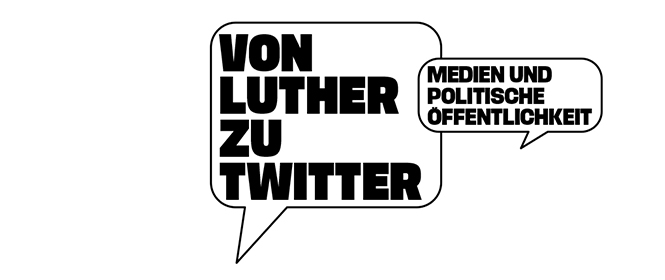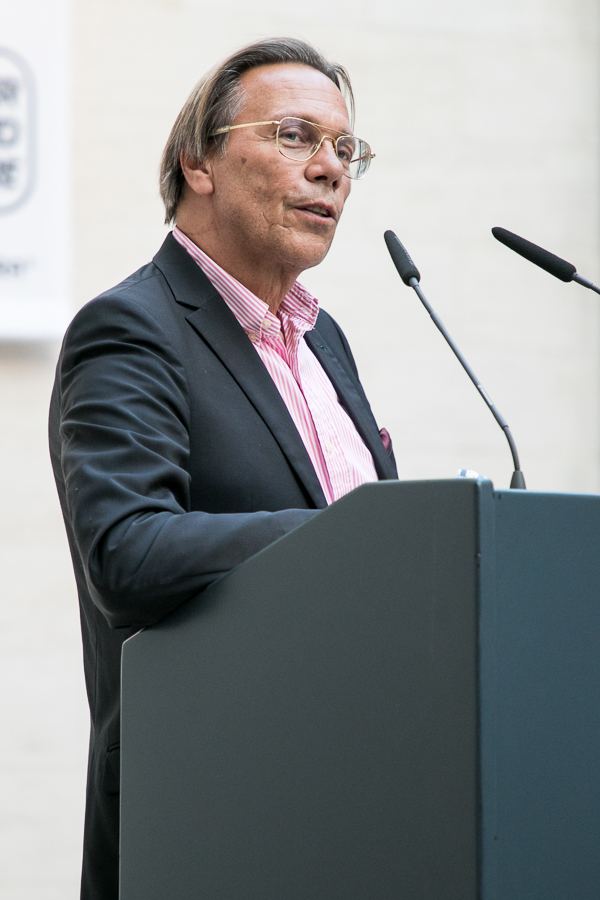
A very Short History of the Political Public Sphere
Harald Welzer | 10 September 2020
On the occasion of the opening of the exhibition “From Luther to Twitter. Media and the Public Sphere” curator Harald Welzer describes a very short history of the political public sphere.
Jürgen Habermas reconstructed the development of the public sphere in his work “The Structural Transformation of the Public Sphere” (1962) and traced our modern form of this realm back to the rise of market societies. These societies need public debate, on the one hand, but also areas of private seclusion in which commercial and political plans and strategies can be developed. This gradually gives rise to the form of interplay between privacy and political public life that still characterises our liberal democracies.
The development of these relations between the private and the public begins with the invention of the printing press, and thus of one of the first mass media, whose importance was recognised above all by Martin Luther. His writings and sermons on the Reformation spread like wildfire. As the historian Marcel Hänggi writes, in 1520 Martin Luther “had already published 27 writings with a total of 900 printed pages in a combined circulation of half a million copies. Even the very expensive complete Bible translated by Luther had reached an edition of 200,000 copies by the time of Luther’s death in 1546. In the first eight years of the Reformation it is said that three million pamphlets were being circulated in Germany.” The Reformation can therefore be seen as “the first major media event of world history” (Heinz Schilling), Luther as the first modern media star.
In the era of the Enlightenment, newspapers and magazines begin to play a role. Battles for attention flared up, developing a medial effectiveness for political articulation that reached an initial culmination in the French Revolution. The public sphere became the embattled realm of political structuring which then established the category of the mass medium. Radio emerged as the mass medium par excellence, initially, however, not primarily as a medium of political discussion, but of entertainment, reportage, news, etc. It was quite a while after its invention and implementation that radio was recognised as a medium capable of shaping a totalitarian public realm. A prerequisite for this development was the perfect synchronisation of broadcaster and listener; the “Volksempfänger”, the people’s radio receiver, promoted by Propaganda Minister Goebbels was the perfect apparatus to synchronise the German folk.
Alongside the Führer’s speeches, live broadcasts of mass rallies of the Nazi Party and, later, the coverage of the war, “soft propaganda” in the form of entertainment programmes and formats like the musical request shows had, particularly since the mid-1930s, assumed an important function in forming an exclusive “Volksgemeinschaft”, a community of the people. But like every medium, radio is polyvalent: while there is no doubt that specifically choreographed radio propaganda functions as a formative medium, other news reports can also be received from outside sources, “enemy” radio stations, for example, which provide a different picture of the course of the war than that alleged by the propaganda.
In post-war European societies a further key medium soon appeared alongside radio: television asserted a lasting influence on the public sphere in the 1960s and 1970s. Like no other medium before it, television, popular with all social classes, independent of age, education or political orientation, structured the day-to-day life of the people, ranging from the design of the living room to plans for the weekend. Every Saturday at 6:30 pm, starting in 1961, the sports show was not to be missed, followed by recurrent family series with such titles as “Einer wird gewinnen”, “Das goldene Schuss”, “Dalli Dalli” or “Wünsch Dir was”. With blockbusters like the crime serials or spectacular live transmissions of global events such as the moon landing, the mass medium television had a formative influence on viewers and thus changed the political culture. A stronger personalisation and a staging of private life are among the strategies contrived for the American election campaigns – particularly for John F. Kennedy – and which then played an important role in the Federal Republic, as exemplified in the political style of Willy Brandt. Political sovereignty was now conveyed through strong visual gestures.
But the power of the television image was also able to bring about completely unexpected political mobilisations, such as the demonstrations against the first war to be broadcast straight into the living room, the Vietnam War. Terrorist organisations then generated unrestricted communication by exploiting the strong visual medium to inflate the impact of even their less spectacular attacks.
This brings us to a further medial formation directly interlinked with its predecessors, namely the digital media and the Internet as well as the excessive surveillance and control functions legitimised by the fight against terrorism. This quickly dashed democratic hopes that had been placed in the medial opportunities offered by the triumphant appearance of the personal computer in the 1980s and the introduction of the World Wide Web.
Since the first decade of this millennium, inventions such as personalised search engines, social networks and in particular the omnipresent smartphone have at the same time enabled the mass collection of user data, which with surprising speed turned the new possibilities of personal influencing into new possibilities of surveillance, behavioural predictability and manipulation. This medial environment has brought about a change in political styles, perhaps most conspicuously in the highly sensitive and professional field of foreign policy, which is being replaced by the spontaneous twittering of more or less clear-sighted politicians. And the political landscape is becoming more volatile: movements that have been mobilised online, ranging from the New Right to Fridays for Future, are gaining political weight.
The future development of the media and the public sphere is up in the air: we are currently in the midst of a rapid structural transformation of the public sphere with no foreseeable end. But the nearly global populist movement suggests that the democratic public is facing ever greater pressure. Fake news, filter bubbles, smear and hate speech, mobbing on the one side and the perfect formation of an historically unique totalitarian surveillance state in the case of China on the other indicate that the universalisation of criteria for the redactional scrutiny of facts and circumstances, of qualified reporting, of the potential equilibrium occasioned by the “Fourth Estate”, of democratic participation – all this has arrived at a point of no return beyond which, for the time being, a consensus of standards will no longer continue to grow.
 |
Harald WelzerHarald Welzer is a sociologist and social psychologist. Together with Melanie Lyon, he curated the exhibition “From Luther to Twitter. Media and the Public Sphere”. |